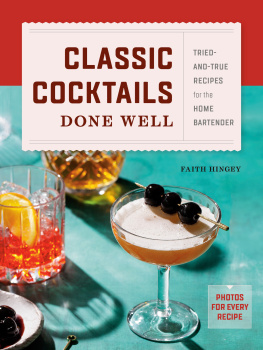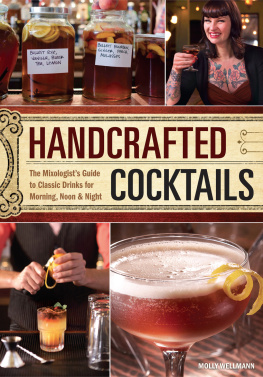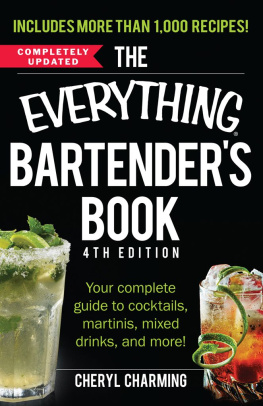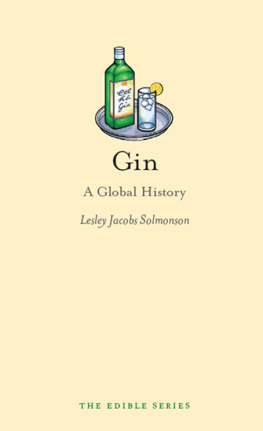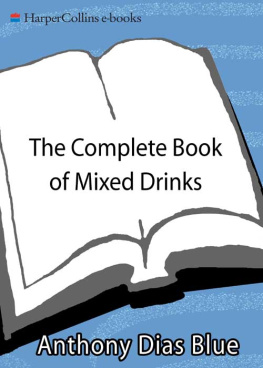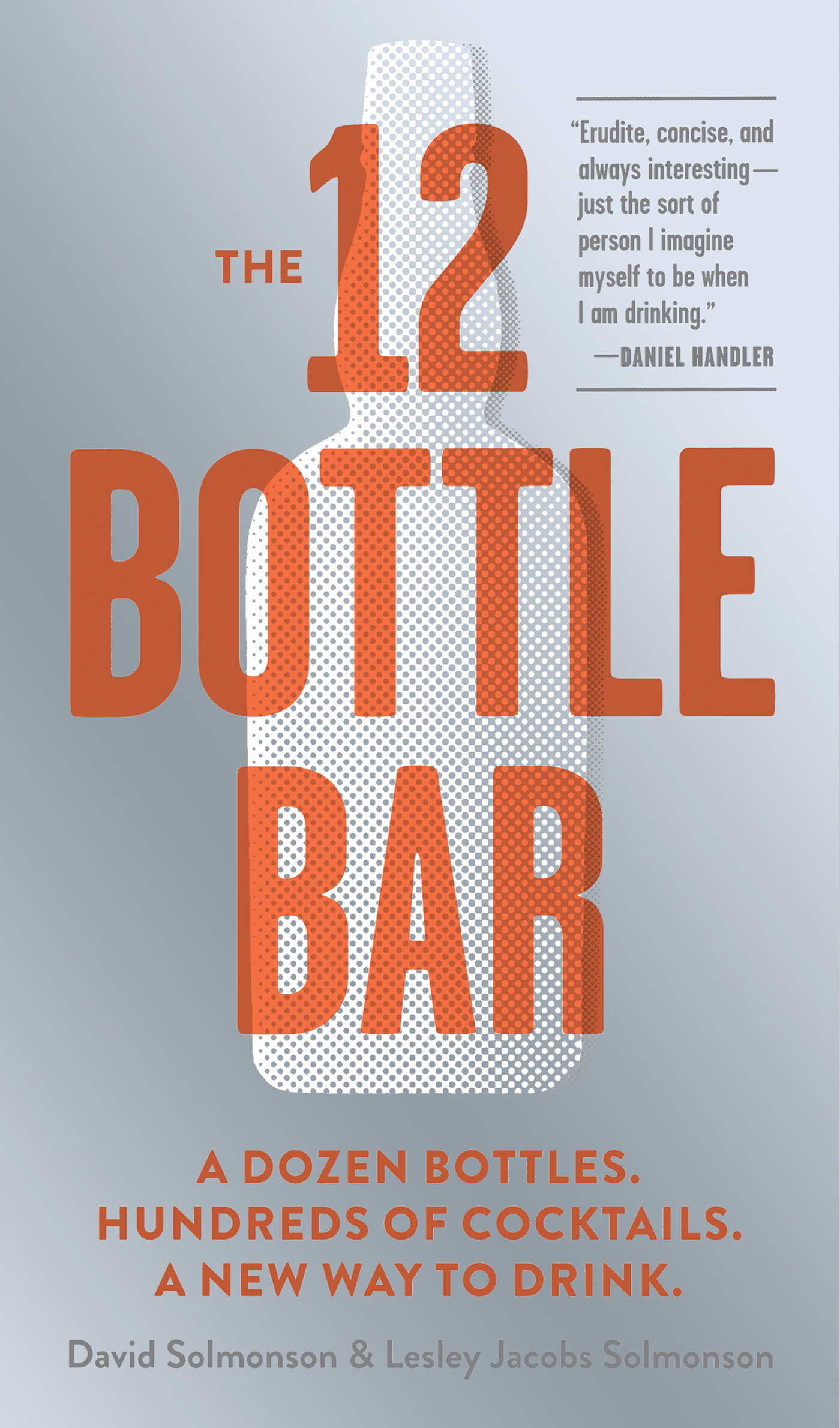The 12 Bottle Bar
A dozen bottles.
Hundreds of cocktails.
A new way to drink.
David Solmonson & Lesley Jacobs Solmonson
Workman Publishing | New York
Dedication
To Raleigh, the greatest cocktail weve ever made.
Contents
Introduction
With the classic cocktail renaissance upon us, it has never been easier to enjoy a well-crafted drink. Bars across the countryand the worldare embracing old-school practices. Recipes from master mixologists appear regularly in magazines, and the new breed of cocktail book on the market extends far beyond the Old Mr. Boston. So why another cocktail book, particularly from two people who make no claims to being professional bartenders?
The road to the 12 Bottle Bar began, aptly enough, with a drink. A Penicillin, to be exa ct, which, at the time, no one knew would become a modern cocktail classic. It was the creation of bartender Sam Ross, but the man who made it for us was Chef David Myers. When we met Chef Myers more than ten years ago, we were utterly disillusioned with the lack of creativity in the Los Angeles food scene. Myers and his restaurant Sona changed all that. Not only did Sona quickly become the restaurant version of the Cheers bar for us, but it also became the platform upon which we expanded our culinary knowledgeand, as it turned out, our cocktail understanding and enthusiasm.
One night, when the restaurant was getting quiet, Chef Myers snuck out of the kitchen, grinning like a kid at Christmas. Ive got to make something for you, he said, grabbing a shaker and assembling a bunch of ingredientsScotch, honey syrup, ginger syrup, and a mist of a second, peaty Scotch. As he mixed up a drink, he told us he had just gotten back from a speakeasy bar in New York called Milk & Honey. That was where he met Sasha Petraske, Milk & Honeys owner, and tasted bartender Sam Rosss Penicillin, which rocked his (and soon after, our) world. Now he said, he was on a mission to kick-start the L.A. cocktail renaissance.
Sona eventually closed its doors, but David Myerss promise to get L.A. cocktail culture going held fast. His bistro, Comme a, was one of the first spots in the city to focus on pre-Prohibition cocktails and, to date, has launched more bartending careers than you can count. As we tasted more and more of these drinks, we quickly started to realize that there was an enormous gapmore like a chasm, reallyin our spirits knowledge, and that the missing link just happened to be the golden age of cocktails. That was the era when a bartender and showman named Jerry Thomasa name you will hear us reference time and time againruled the proverbial roost. That was the era when, not only because it tasted better but because you could do no differently, cocktail ingredients were made from scratch, ice was carved with a pick, and bartenders were serious career professionals.
Suddenly, we felt a little cheated. After all, we had grown up in a world where ingredients like sour mix, techniques like topping off an Old Fashioned with club soda, and drinks like the Long Island Iced Tea were the standard. We started to understand what cocktails could be and we were thirsty to learn more.
The Why and What of 12 Bottles
Like most modern cocktail lovers, we went a little crazy in the beginning, grabbing whatever we could find to fill in the blanksDavid Wondrichs Imbibe! was a game changer for us, as was David A. Emburys The Fine Art of Mixing Drinks (because Embury, like us, was not a professional but an enthusiast who saw cocktails as an art form in their own right). Much as home cooks enthusiastically try out recipes and experiment with flavors, we enjoyed tinkering in the liquor cabinet. After all, when the price of the average classic cocktail often starts around $15, going out becomes less about having fun and more of a financial investment. However, when we started trying to recreate the recipes we tasted in bars, read about in magazines, and found in modern mixology books, it turned out to be arduous, expensive, and sometimes downright impossible. Why was it that every new recipe demanded expensive ingredients that we didnt normally have on hand? As cocktail lovers, we admittedly have a pretty extensive liquor cabinet, but even we were amazed by how few drink recipes we could make without buying the newest bottle of Crme dEsoterica, usually at $50 or more a pop (not exactly cost-effective when all you need is one teaspoon).
Of course, all of this just made us ask the question: How do we make the same classic cocktails at home that dot the pages of glossy magazines and are on offer in almost every forward-looking bar, as well (if not better), and without breaking the bank? And so, late into the night after long workdays, an idea was born.
We loved classic cocktails, but not the overly complicated or costly modern riffs on them. We believed that enough drinks could be made with a limited set of bottles to satisfy the majority of home bartenders. With that conceit, we launched 12bottlebar.combuilt on the premise of 12 Bottles, Endless Tasty Concoctionsin October of 2009. Through the site we were able to connect with the cocktail community at largewhich was incredibly generous to two admitted neophytes like us. When the opportunity for this book came along, the relationships we had cultivated while writing on the site bloomed into friendships that produced many lovely cocktails, bits of advice, and stories for the book. For those contributions we are, corny as it sounds, eternally grateful.
But back to the basic idea: Why 12 Bottles? When we first started studying recipes, we quickly realized two very important things. First, most contemporary cocktail books dont cater specifically to the home bartender, that is, those of us with limited space and a limited budget. Not to be defeated, we started seeking out old-school cocktail books from the formative days of drinking (the late 1800s mainly), a time when the selection of spirits was much more limited. Which brings us to point number two.
It turns out that a vast number of classic cocktailsboth historic and moderncan be made with a pretty obtainable and maintainable collection of hooch. This made perfect sense to us. Every home cook keeps a well-stocked pantry from which to draw ingredients. Why shouldnt home bartenders have a similar arsenal, a sort of spirits pantry? The answer is simplethey should.
How This Works
The 12 Bottle Bar is the home bartenders arsenal, pantry, tool kitthe answer to entertaining confidently. With only twelve bottles (seven spirits, one liqueur, two vermouths, and two bitters) you can make literally hundreds of classic cocktail recipesmore than you ever will, or at least, ever should, drink. Add to that a little basic knowledge of fresh fruit juices and simple-to-make syrups (on pages; good-bye, sour mix!), and you have everything you need to produce freshly made, old-school, budget-minded cocktails at home.
By now you are probably asking, why twelve bottles and why these particular twelve bottles? While you can certainly go with fewer bottles if, for example, you dislike rum or whiskey or gin, these twelve bottles cover the vast spectrum of drink profiles and styles. (That said, if you want to trim the list, see .) And rather than just go with a predictable list, weve thrown in genever, one of the oldest spirits known to man. So, here are our essential bottles.
Brandy, Dry Gin, Amber Rum, Whiskey These are the big four, the cornerstones of any good bar. Based on the recipes in existence, there are simply some spirits that you must have in your tool kit.


